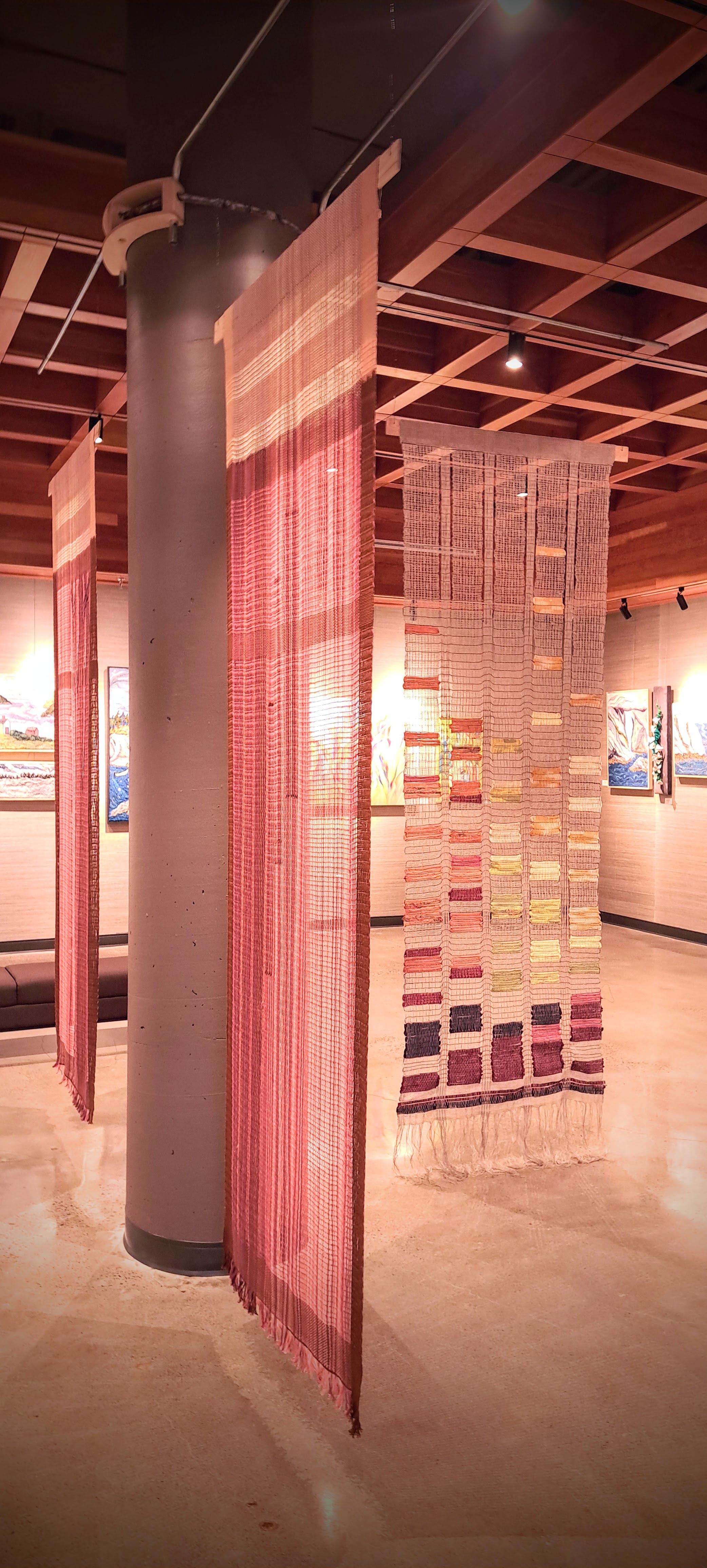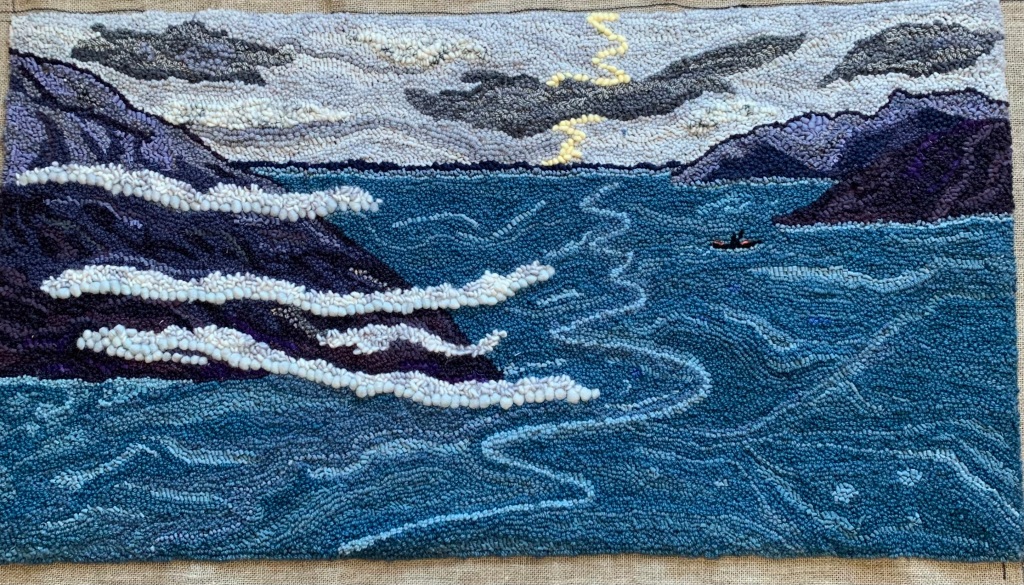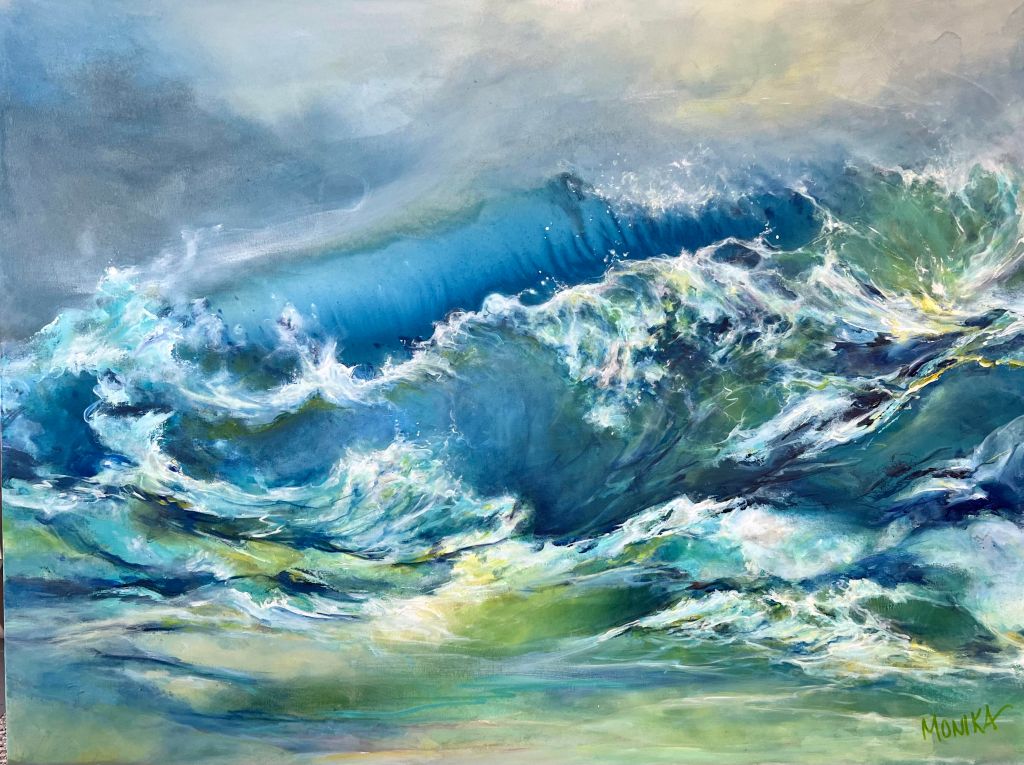




Shown in reView, clockwise from top left, Along Mill Road, Christiane Poulin; The Universe Within, acrylic on canvas, Monika Wright; Glimpse of Aqua/Teal Stairs Between Paintings, oil and acrylic on board, Mary Barnard Fitzgerald; Jawbone, bone, plaster, dyes, Genny Killin; Waves, wool on linen, Carla Middelburg.
Colour, pattern and content weave in and out with startling connectivity in reView, a five-woman exhibit at the Chase Gallery, Nova Scotia Archives, to Jan. 29 with a meet-the-artists event this Saturday, Jan. 20, 1 to 3 p.m.
This bright and beautiful, uplifting show is a cooperative venture by HRM artists Genny Killin, Monika Wright and Christiane Poulin with Baie Verte, N.B., rughooking artist Carla Middelburg and Windsor, Ont., painter Mary Barnard Fitzgerald. (Fitzgerald grew up in Nova Scotia and happens to be my sister, of whom I am so proud.)
Rarely is a show curated in a way that so thoroughly propels disparate art pieces into conversation and connection.
As the artists gathered to intersperse their works they first chose to hang Wright’s diptych, Seeking Tranquility, framed on either side by Killin’s Priori and Remant.
Apart from being beautiful – Wright’s rich purples in branch-like mesh and flame patterns, Killin’s stark white sculptural forms against black velvet – this pairing has a sacred, spiritual feel.

Wright’s stunning, light-shot green/blue wave paintings are hung with Middelburg’s tufted, textural pictures of highly animated waves. Fitzgerald’s twisting, dancing gingham ribbons yearn towards the sinewy, snaking forms in work by Wright, Middelburg and Killin.
It’s fun to look through Poulin’s woven hangings – nature-based and architectural and full of light and lightness – at the paintings on the wall. Her work adds warmth and a centre to the large gallery while her colours in the realistic Iris speak directly to Wright’s and Fitzgerald’s purples and yellows on an opposing wall.
These five artists, linked by friendship, share a love of nature, a passion for colour and light, a leaning towards abstraction, an interest in movement and an exploration of space – interior, exterior and within the body and the soul.
Killin and Middelburg are both keen kayakers and hikers; however, their work differs.

Middelburg hooks in lovely knubbly textures, with hints of metallic threads , realistic depictions of the sea coast – rock, treelines, cozy, country houses and even the kayak itself bouncing on water. Her pure wave forms are abstracted, and beautifully animated, as strong as fish tails about to thump down. She incorporates playful, paisley patterns like sea spray and hooks red waves as if they are illuminated by the light of a dipping red sun.
Middelburg, who studied at the Banff School of Fine Arts and Aprerion workshops in New York, uses wool for its textures and tactile quality. “I mostly dye all my own wool for my values and colour palette,” she says, and her designs come from the photographs and sketches she does on her sea kayaking trips in Nova Scotia and Newfoundland.
Killin transforms the whitened bones, tide-beaten sticks and metal objects she finds on Atlantic Canadian beaches into iconic forms full of ambiguity and resonance as she sets these objects on black velvet or sensuous, coloured surfaces.
In Weed, she transforms a twisted stick, attaching incisor-like animal teeth and painting it a striking greenish yellow. The seaweed-like form swims above a dreamy, colour-saturated surface of dyes over pitted plaster in colours of varying blues and purple.
Marrakesh is a church window shape holding a snake-like twig – like Cleopatra’s asp – painted in black and travelling from a gold painted disc over an empty hollow to a second gold disc. These discs, set on a dreamy blue surface, are rusted washers she found in a Newfoundland outport.

Killin, who has a BFA from NSCAD University, starts with an idea and, if it’s not working, plays with materials, textures and colours “until I get a solution.”
“At the end,” she says, “I want my pieces to have gravitas, beauty, mystery, or a sense that they are trying to convey something of depth, time. I want them to be artifacts. I want them to connect … somehow … to the first humans who made marks on rocks or sticks or caves – useless acts that are bigger than oneself and our puny histories.”
Before the pandemic Mary Barnard Fitzgerald (and I) went on a short trip to the Parrsboro shore. She became fascinated by Ilse Haut as seen from Advocate Harbour beach. This storied island right in the middle of the Bay of Fundy appears as a distant, mysterious chip of land with high, forbidding cliffs.
It has popped up ever since in Fitzgerald’s paintings as a distinctive shape at the end of zig-zagging lines of hot colour; this motif is usually placed within a fanciful picture frame within the painting’s larger, interior world – a surreal world of cascading stairs in patterned, decorative carpet; billowing multi-coloured gingham curtains, exquisitely-rendered wainscoting and tilting lampshades.

Reds and Greens and Light Breeze, oil on canvas, Mary Barnard Fitzgerald. (courtesy of the artist)
This space could belong to a medieval castle, a sea captain’s house, an exotic hotel, the corridors of the mind. While the colour and pattern are dazzling, the mood varies from one of entrapment to enchantment. The frames within frames – all vintage and old-fashioned – may contain eyes or yet more spaces.
It’s not surprising people at the opening were reminded of Alice in Wonderland and M.C. Escher. Fitzgerald, herself, who has a BFA from NSCAD University, is often intensely concerned with balancing disparate colour and refining her beautiful, precise shadows. She likes to describe her work as“abstracted realism.”
While so different in composition – geometrics and architectural space for Fitzgerald, organic lines and spatial depths for Wright – these two artists are masters at colour and balancing seemingly disconnected colour.
Most of Wright’s acrylic paintings in reView are from her Abstract Series though she includes a couple from her Sea and Land Series. The viewer can get so beautifully — peacefully — lost travelling down her vortexes then bouncing back to surface movement. These pictures can reference skies, oceans, the cosmos or be interior states of mind and feeling.

Wright, who developed her unique style after moving to Nova Scotia in 2005 and now exhibits internationally, does not use reference materials for her work.
“For the wave paintings, I try to create the power of water, the motion and energy. I do this by becoming the water in my mind – moving my body with the paint the way it would move in a storm, moving my mind’s eye as the water would move, is how I get that wildness. It isn’t about being realistic; rather about representing the feeling of getting caught in the wave.”
For her pure abstracts she begins with a few colours then moves and layers her paint on canvas or wood panel “moving the paint with brushstrokes and tools across the surface,” she says.
“I allow myself the freedom to absorb the energy from the universe, becoming a funnel through which it flows onto the canvas, especially in the beginning. I think that’s where all that organic movement comes from. Then I create layers upon layers, just like creating a life, in order to complete the artwork.
“I’ve learned that the paintings that have the most impact are the ones where the viewer has a visceral reaction, perhaps one that can’t even be explained. It’s an inner knowing or connection.”
Softening all the high-key colour and swooping movement are Poulin’s delicate, serene, conceptual and nature-based hangings including her four-piece Echoes suite of rust and yellow depictions of trees and a sun with abstracted geometric bars.
Her latest work, Along Mill Road, is “an experimental piece that explores the positive and negative spaces produced by two different weaving techniques: catalogne and leno-lace,” says Poulin, who also has a BFA from NSCAD University.
“Catalogne is a traditional technique in which the weft consists of strips of old cloth inserted into a plain tabby weave. Leno-lace is a diaphanous weave produced by twisting groups of warp threads.”
Her intent in Along Mill Road is to “evoke the colours, and light and shadows, of an autumn woodland in an abstract form. Set against a background of unbleached linen leno-lace, the strips of reclaimed hand-dyed cotton suggest the chartreuse and yellows of the tamarack, the crimson and orange of the maple, and the purple and burgundy of the sumac.”
Gallery hours at the Archives, 6016 University Ave., are Monday to Friday, 8.30 to 4.30; Wed., 8.30 to 8; Saturday, 10 to 3.

- All the World’s a Vision for 1 artist and 3 sets of 2
- True or False? The Gift leaves you mesmerized by magic and mystery
Categories: Uncategorized
Tags: abstract, acrylic, Art, artist, painting